Wondering about your kitten's future coat length? While all kittens start life with soft, fluffy fur, there are several reliable ways to predict whether your furry friend will grow into a longhaired or shorthaired cat. From genetic factors to physical characteristics, this comprehensive guide will help you understand what to look for and when.
Understanding your kitten's eventual coat length isn't just about curiosity – it can help you prepare for future grooming needs and care requirements. Let's explore the key indicators and timeline of kitten coat development.
Genetic Factors That Determine Coat Length
Your kitten's coat length is primarily determined by genetics. The longhair trait is what scientists call "autosomal recessive," meaning both parents must carry the gene for a kitten to develop long hair. This genetic pattern makes it easier to predict coat length when you know the parents' characteristics.
If both parents are longhaired, all kittens in the litter will likely develop long coats. However, if both parents are shorthaired but carry the longhair gene, approximately 25% of their kittens might become longhaired.
Key Physical Indicators at Different Ages
Birth to 8 Weeks
During the first two months, all kittens have similar soft, fuzzy coats regardless of their future hair length. This baby fur makes it challenging to predict adult coat type with certainty during this early stage.
8 to 12 Weeks
Around eight weeks, future coat length becomes more apparent through several physical signs:
- Fluffy, plumy tails
- Visible ear tufts
- Fur between toe pads
- Developing neck ruff
- Longer belly fur
3 to 6 Months
By this age, coat characteristics become much more obvious. Longhaired kittens will show increasingly prominent features like:
- Pronounced ear furnishings
- Distinct neck ruff development
- Notably fluffy tail
- Longer fur around the belly and britches
Important Physical Features to Check
When trying to determine if your kitten will have long hair, focus on these specific areas:
- Tail fullness and shape
- Ear tufts and furnishings
- Toe tufts between paw pads
- Neck area for early ruff development
- Overall coat texture and thickness
Professional Assessment Options
If you need a definitive answer about your kitten's future coat length, consider these professional options:
- Veterinary consultation
- Genetic testing for the FGF5 gene
- Professional breeder evaluation
- DNA testing services
Frequently Asked Questions
How can I tell if my kitten will have long hair before it grows in?
Look for early indicators like ear tufts, fur between the toes, and a fluffy tail around 8 weeks of age. These physical characteristics are strong predictors of a future longhaired coat.
What physical signs at 8–12 weeks indicate a kitten will become longhaired?
Key signs include a fluffy, plumy tail, prominent ear tufts, fur growing between the toes, and the beginning development of a neck ruff. The overall coat may also appear slightly longer and fluffier than that of shorthaired siblings.
Does the coat length of my kitten's parents predict if it will have long hair?
Yes, parental coat length is a strong predictor. If both parents are longhaired, the kitten will almost certainly be longhaired. If both are shorthaired, the kitten will likely be shorthaired unless both parents carry the recessive longhair gene.
Can a longhair genetic test reliably tell me if my kitten will have long fur?
Yes, genetic testing can provide a definitive answer by detecting the presence of FGF5 gene mutations responsible for long hair in cats. These tests are highly accurate and can be performed at any age.
Why do some kittens look fluffy at birth but later develop short hair?
All kittens are born with soft, fluffy baby fur regardless of their eventual coat length. This kitten coat is gradually replaced by their true adult coat between 6-12 months of age, revealing their permanent hair length.
Conclusion
While early prediction of a kitten's adult coat length requires attention to specific physical characteristics and timing, the signs become clearer as your kitten approaches 8-12 weeks of age. By observing key features like ear tufts, tail fullness, and toe fur, combined with knowledge of parental coat types, you can make an educated prediction about your kitten's future coat length.






